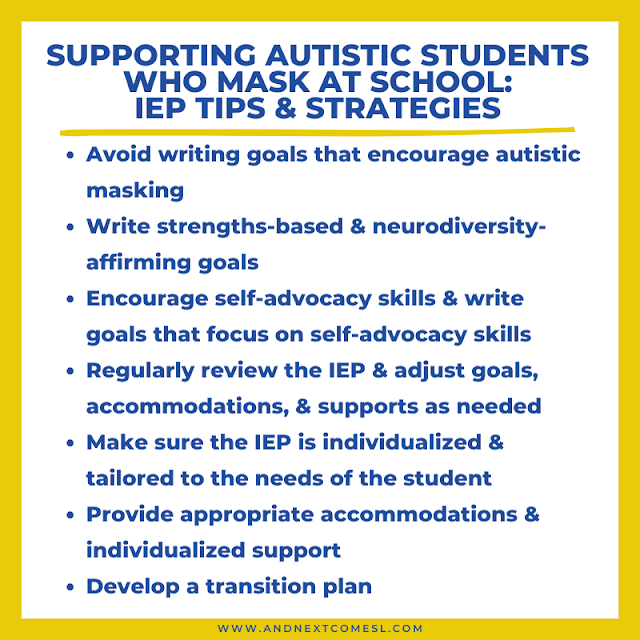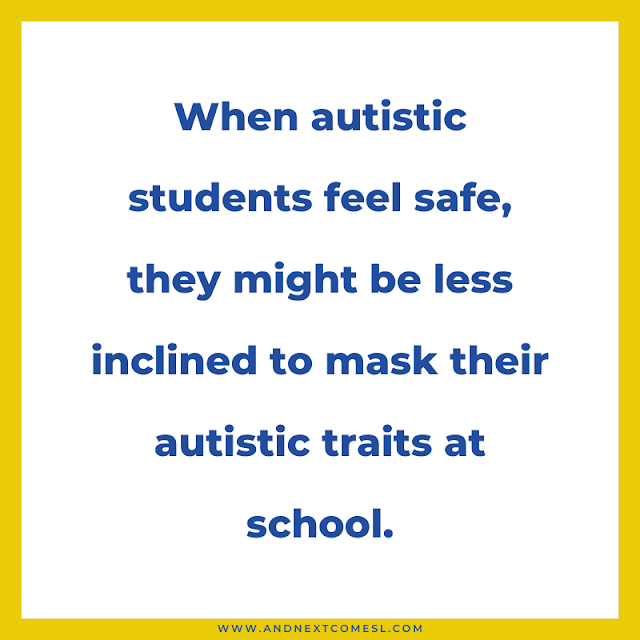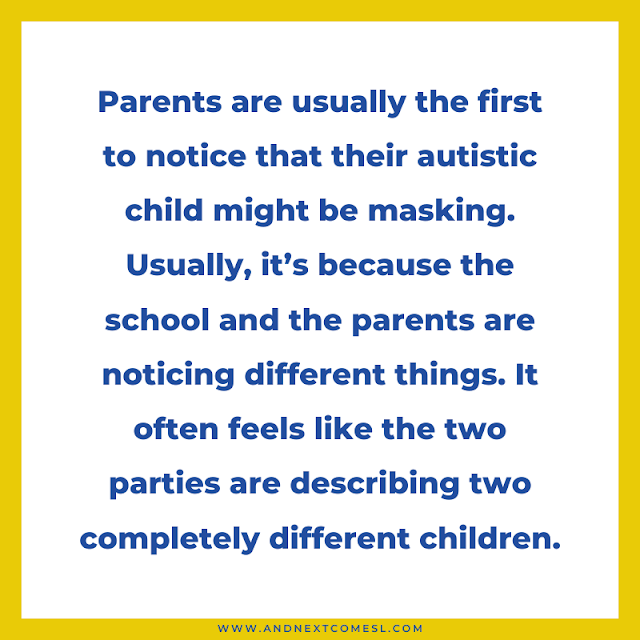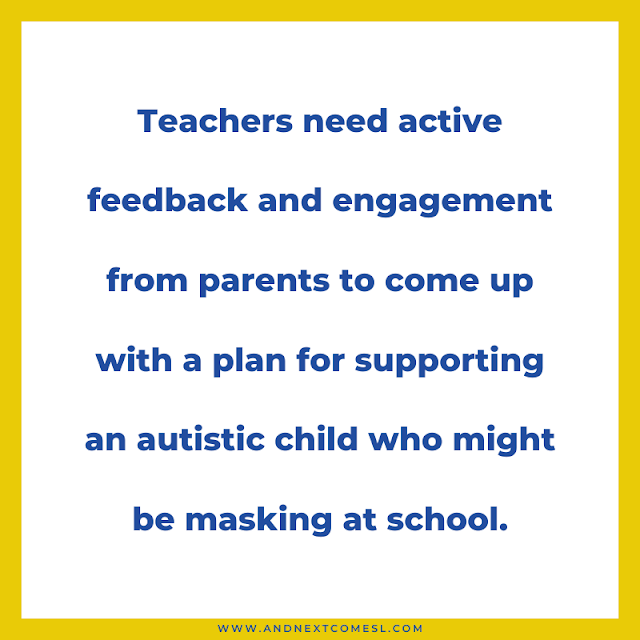Do you suspect that your autistic child is masking at school?
Or maybe you're a teacher and you've noticed that a student of yours seems to be masking their autistic traits.
Perhaps you're wondering what you can do to help support these students and maybe help them unmask a little...After all, it's quite common for children to mask their autism at school.
But how exactly do you help a child who is masking at school?
Well, below you will find a variety of tips and strategies for supporting autistic students who mask at school.
We'll look at classroom strategies, teaching tips, and IEP tips. Then we'll look at the importance of collaborating as a team and how teachers and parents can work together to support the autistic child who masks. So let's dig in!
Classroom Strategies & Teaching Tips for Helping Autistic Kids Who Mask at School
There are lots of things that teachers can to support autistic kids, regardless of whether or not they know an autistic student is actively engaging in masking behaviors. In other words, the following strategies are just good everyday tips to keep in mind. For instance, teachers can:
- Implement visual supports to support verbal instructions
- Offer flexible seating options
- Provide different learning options
- Use materials and strategies that don't encourage or promote masking behaviors (i.e., you'll want to avoid criss cross applesauce, quiet hands, demanding eye contact, and behavior charts)
- Provide regular sensory breaks throughout the school day
- Provide access to fidgets, sensory tools, and coping strategies
- Use clear language when giving instructions and avoid using non-literal language
- Build an inclusive classroom culture
- Create a sensory-friendly classroom environment (e.g., flexible seating, calm down corner, dim the lights, reduce visual clutter)
- Recognize that there are a variety of different learning styles in your classroom and try to use strategies that are accessible to these different learning styles
- Use a structured and predictable routine
- Provide advanced notice of any changes to the schedule, if possible, and give the student clear warnings about those changes
- Use accessible curriculum and materials
- Support social skills development through peer education, inclusive social activities, explicit teaching, modeling, social stories (when written well - there are lots of bad ones out there), etc.
- Don't discourage stimming or other autistic traits
Remember, a lot of these tips and strategies are good practice, autism masking or not. That means that implementing these tips will help create a safe environment. An environment in which autistic students might feel more comfortable letting the mask drop a bit.
IEP Tips & Strategies for Supporting Autistic Students Who Mask at School
It's quite common for school teams to write IEP goals that, unfortunately, encourage autistic students to learn masking behaviors. So, IEPs are actually a really great place to start when it comes to addressing concerns about masking at school.
Here are some tips to keep in mind when it comes to the IEP process:
- Avoid writing goals that encourage autistic masking (e.g., eye contact goals)
- Write strengths-based and neurodiversity-affirming goals
- Encourage self-advocacy skills and write goals that focus on self-advocacy skills
- Regularly review the student's IEP and adjust goals, accommodations, and supports as needed
- Make sure the IEP is individualized and tailored to the needs of the student
- Provide appropriate accommodations and individualized support
- Develop a transition plan
A lot of these IEP tips are what we call IEP green flags. They are the things we generally want to see when it comes to IEPs. And they can help reduce the need to mask in the classroom.
Collaborate With Parents, the Student, & Other Support Staff About Autistic Masking
It's important to remember that parents and the school staff should work as a team when it comes to supporting autistic students in the classroom. But it's also important to consult other relevant professionals, such as a speech therapist or occupational therapist. And don't forget to include the student themselves!
Here are some tips to keep in mind when it comes to collaboration:
- Listen to parents about their concerns and seek their input about how to best support the autistic student
- Collaborate with specialists such as speech therapists, occupational therapists, etc. to better understand the child's sensory needs and learning style and find appropriate strategies and supports to meet those needs
- Learn from and include autistic perspectives, if possible
- Share feedback with parents about what you are noticing in the classroom and discuss how that differs or not from what the parents are seeing at home
- Listen to and validate the student's needs, their struggles, and/or any concerns they may have
- Talk about after school meltdowns and school exhaustion and how that might impact things like school performance, homework expectations, participation in extracurricular school activities or field trips, etc.
Bottom line: opt for a team approach and actively collaborate with parents, the student, and other support staff. It's an easy way to ensure that the student feels heard, valued, well supported, and, most importantly, safe. And when students feel safe, they might be less inclined to mask their autistic traits.
What Parents Can do to Support Teachers When it Comes to Autism Masking
Parents are usually the first to notice that their autistic child might be masking. Usually, it's because the school and the parents are noticing different things (i.e., it feels like the two parties are describing two completely different children). See more signs of autism masking in children here.
So, more often than not, it will be parents who start the discussion of autism masking with the school staff.
But how do you start talking to your child's school about autistic masking?
Well, here are some things that parents can do:
- Help the school staff understand what autistic masking is, especially if they aren't familiar with it yet, and what that looks like for your child
- Educate the school staff about autism and autistic traits (sometimes the school staff might have incomplete, outdated, and/or incorrect information about what autism actually is)
- Collaborate with the school team to better understand the child, what their anxiety triggers are, and come up with a plan and IEP goals that make sense
- Keep communication channels open
- Share any strategies or tips that help the child feel safe, calm, and well regulated at home
- Inform the school about anything that might be going on at home that could be impacting their school experience (e.g., big life changes, sleep changes)
Teachers need active feedback and engagement from parents. After all, parents know their children much better than teachers do. They can work together though to come up with a plan for supporting a child who might be masking at school.
How Do You Help a Child Who is Masking at School? A Quick Recap
It's one thing to know the signs of autism masking at school, but it's a whole other thing to know how to support the child who masks at school.
As you can see from above, there are a wide variety of strategies and tips to try. Here is a quick summary of what was discussed above:
- There are lots of different learning styles so classrooms need to be sensory-friendly, inclusive, supportive, and accessible to all. That includes learning materials and curriculum.
- IEPs are a great place to address concerns about masking at school. Instead of writing goals that actively teach autistic masking, goals should be strengths-based, neurodiversity-affirming, individually tailored to the student, and encourage the development of self-advocacy skills.
- It's important for the school, parents, the student, and other support staff to collaborate and work together as a team. Input from all should be considered when designing a support plan.
- Parents play a big role in supporting teachers when it comes to autistic masking. They might have to help educate the school staff about autism, masking, and other autistic traits in order to make sure their child is well supported at school.
There are no hard and fast tricks here. Instead, the goal is to arm you with suggestions and strategies for supporting autistic students who mask at school. That way you can develop a support plan. And, hopefully, you now have plenty of ideas to consider.











